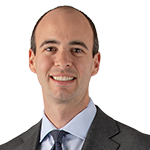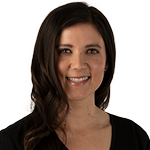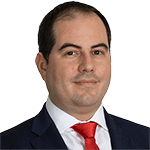Global Perspectives: Making sense of market trends for portfolio construction
In this episode of our Global Perspectives podcast, Adam Hetts, Lara Castleton, and Mario Aguilar from the Portfolio Construction and Strategy (PCS) group cover key themes from the team’s latest Trends and Opportunities outlook and discuss the biggest trends they are seeing in client portfolio consultations.
21 minute listen
Key takeaways:
- As we enter a new era characterized by structurally higher interest rates and fresh discounts across major global asset classes, we think investors will need to tread carefully, which requires a delicate balance of defense and offense.
- Key themes for fixed income in 2023 include the return of yield cushion, the potential benefits of adding duration, and credit offering an attractive risk-adjusted opportunity given the uncertain outlook for equities.
- In equities, we think the cyclical nature and lower relative valuations of European equities vs. the U.S. present strong upside potential. Globally, healthcare may offer growth opportunities regardless of the recession outlook, given the sector’s resilience in past downturns.
Important Information
Diversification neither assures a profit nor eliminates the risk of experiencing investment losses.
Fixed income securities are subject to interest rate, inflation, credit and default risk. The bond market is volatile. As interest rates rise, bond prices usually fall, and vice versa. The return of principal is not guaranteed, and prices may decline if an issuer fails to make timely payments or its credit strength weakens.
Foreign securities are subject to additional risks including currency fluctuations, political and economic uncertainty, increased volatility, lower liquidity and differing financial and information reporting standards, all of which are magnified in emerging markets.
Basis point (bp) equals 1/100 of a percentage point. 1 bp = 0.01%, 100 bps = 1%.
Bloomberg Global Aggregate Corporate Bond Index measures global investment grade, fixed-rate corporate bonds.
Dividend Yield is the weighted average dividend yield of the securities in the portfolio (including cash). The number is not intended to demonstrate income earned or distributions made by the portfolio.
Duration measures a bond price’s sensitivity to changes in interest rates. The longer a bond’s duration, the higher its sensitivity to changes in interest rates and vice versa.
Price-to-Earnings (P/E) Ratio measures share price compared to earnings per share for a stock or stocks in a portfolio.
An inverted yield curve occurs when short-term yields are higher than long-term yields.
Yield cushion, defined as a security’s yield divided by duration, is a common approach that looks at bond yields as a cushion protecting bond investors from the potential negative effects of duration risk. The yield cushion potentially helps mitigate losses from falling bond prices if yields were to rise.
Adam Hetts: Welcome to another special edition of Global Perspectives, where I get to interview two of my Janus Henderson team members about the biggest trends they’re seeing in their daily client portfolio consultations. I’m your host, Adam Hetts, Global Head of Portfolio Construction and Strategy, and with me is Lara Castleton, our U.S. Head of Portfolio Construction and Strategy, here with me in Denver, and Mario Aguilar, a Senior Portfolio Strategist on the team based in our London office. So, Lara, welcome back, and, Mario, thanks for joining.
Lara Castleton: Thanks for having us.
Mario Aguilar: Yes, thank you, Adam. Nice to be here.
Hetts: And listeners should keep in mind that this conversation is a companion to our team’s latest outlook, which you can find in the show notes and in the Insights section of the Janus Henderson website. We named this outlook Treading Carefully because our clients are excited right now about the investment opportunities lying in the wake of 2022’s historic sell-off, but at the same time we’re all still dealing with the lingering market shocks of slowing growth, inflation, and a historic interest rate reset.
As we enter this new era with structurally higher interest rates and fresh discounts across major global asset classes, we think investment success depends on treading carefully and balancing the right mix of defense and offence in portfolios. So, Lara, let’s start with fixed income, which is where most client projects seem to be focused right now. Bonds are a historically defensive asset class that just came off the worst year in a generation. What are you telling clients to expect this year and what are the most important changes in most client portfolios?
Castleton: Thanks, Adam. I hate to even bring up the word duration while we’re still grappling with interest rate volatility, but after 450 basis points of Fed rate hikes, one of the biggest themes with fixed income is edging longer out on the curve. There are a couple of reasons for this, but primarily that painful reset of rates last year now leaves longer-duration bonds with a materially higher yield than we’ve seen in years. In fact, the yield to worst on the U.S. Agg [Aggregate Bond Index] average was just 1.3% in 2020. As of yesterday, it’s just shy of 5%. So while the path of inflation and growth remains uncertain, the higher starting yield investors can lock in for longer-duration has become quite attractive.
Now, on top of attractive yield, the other reason is potential capital appreciation and diversification that long-duration bonds can provide. So, while unpredictable, there generally does seem to be a sense that rates may come down at some point in the future. Longer-duration portfolios will have greater capital appreciation potential as rates fall and, if we see a scenario where the market takes a turn for the worse, and equities sell off, we think duration can once again be a great diversifier to portfolios.
Outside of duration, sector-wise, I do want to shine the spotlight on credit for a second. The story of fixed income this year again is really all about the return of yield cushion. Both investment-grade, IG, and non-investment-grade, non-IG credit, the rerating in 2022 also affords those sectors much higher starting yields than they’ve seen in the past. However, it’s important to note that spreads are tight, so they’re sitting near their long-term historical average both for IG and non-IG. So, if we have a recession, these narrow spreads could widen and eat into those robust starting yield cushions. IG credit, however, should serve as a more conservative ballast given those companies have proven to be more stable while non-IG may suffer more losses.
Now, whichever credit allocation investors are contemplating, we would uniformly emphasize actively allocating to the space. So in this uncertain environment, investors really need a manager who can identify strong fundamentals to navigate volatility and default risk. Now, there are other sectors that might present better opportunities in the market right now, but at these higher starting yields and with skilled active management, we think credit can actually be an attractive risk-adjusted opportunity in a year where the outlook for equities is quite uncertain.
Hetts: Thanks, Lara, for covering the bond gambit across duration and credit. And then, Mario, global equities aren’t coming off the worst year in a generation, unlike fixed income, but they were still down double digits last year as inflation and rising rates and slowing growth all got priced in. Then on top of that, Europe had its own unique supply and geopolitical shocks but still somehow finished the year better than U.S. equities. So, Mario, you’re based in London – what’s the sentiment over there in Europe right now and how are you seeing European equities fit into client portfolios?
Aguilar: Yes. So, of course the makeup is different in Europe and European equity markets than it is in the U.S., and what we see here is that Europe offers more of those value sectors than the U.S. So if we put some numbers around that, in the U.S. it’s about evenly split, 50-50, in what could be called cyclical versus those more defensive sectors. Europe is predominantly more defensive, so you’ve got about 60% in this space, but Europe – remember, it’s still a global investment destination where you have global leaders in spaces like consumer, energy, financials, and materials. So these are defensive sectors that can perform well in the face of rising rates.
Then, additionally, valuations are cheaper in Europe, maybe because the U.S. has run ahead over the past 10 years versus Europe. In Europe, the P/E [price-to-earnings] ratios are currently at about a 20% discount versus their 10-year average, whereas in the U.S. they’re pretty much even. So you have that additional valuation angle that I think benefits Europe going forward. This discount bakes in already those negative news that I mentioned with the war in Russia and Ukraine, the energy crisis, you name it. So any positive news on this front could actually turbocharge those returns going forward.
The last bit that I want to mention on why we think European equities are attractive is the dividends. Dividends have historically been higher in Europe; they’re currently at about 3% versus 1.75% for the U.S. Dividend yields could potentially become a higher proportion of total return over the coming years as opposed to share buybacks. In the U.S., share buybacks is what was driving that equity yield whereas in Europe it’s been that dividend yield. I think that’s what makes this space quite attractive from an investment point of view.
Hetts: Great. So, I’ll stick with you a little bit more on equities. What’s top of mind for you outside of just Europe?
Aguilar: Healthcare, I think, is a sector that we’re seeing global interest in. You said earlier we have to think about defense and offense, and I think that’s what’s exciting about this sector. If we think about healthcare in general, 85% of the sector could be classified as defensive. This is where you have those large pharmaceuticals, medical device makers, healthcare services. The defensiveness … I think 2022 was a good proof of that, in which you have the healthcare sector down about 5% whereas the market was down multiples of that, close to 20%.
I think this is intuitive. If we think about it, healthcare and medicine is something that we would all need regardless of the state of the economy, but there’s also some secular drivers to this. The population is aging over the world mostly. If we take the U.S. as an example as the biggest market for healthcare around the world, we know that it’s people that are age 65 and older that will demand more healthcare, and this is a space of population that’s growing.
A stat that surprised me from the Atlanta Fed is that for last year, the number of prime-aged workers in the U.S., those aged between 25 and 54, grew by about 40,000, but the population of 65 and older grew by 2 million. So that’s where the sustained demand will come from. We also know these are baby boomers that have savings, good retirement balances, so the demand for that defensiveness is going to be there over time.
I said earlier that about 85% of the healthcare sector is defensive and the other 15% is the exciting one and this is biotech. This is where the offence comes from. Biotech itself has a majority of small and mid-sized firms that are inherently volatile but are offering promising new drugs, but there’s also larger firms that behave more like traditional pharma. So that’s another dose of defense. So you have this defense-offence in your portfolio. As we say in sports, the first defense is offense. So I think that’s what pack this is in. But what are the secular trends within biotech? Again, the FDA is pushing for more drug approvals. In fact, drug approvals are at the highest rates in decades, and this will open up opportunities for blockbuster sales. This will trigger M&A activity, especially of firms that were aggressively rerated and now find themselves trading at levels below those of cash on their balance sheets. So that could generate returns regardless of what happens with the economy.
In short, I think there are many opportunities coming in different shapes and forms, making healthcare a very exciting, promising sector and one where I believe an active approach could be the key to investment success.
Hetts: Thanks, Mario, for the recap on European equities and healthcare there. So you mentioned the defense and offense, and I think that has resonated across our client conversations globally and that’s why we named our outlook Treading Carefully. But at the same time, our client conversations can be very different across different regions, so, Lara, back to you. Based on talking to your U.S. clients and then our global team members like Mario, what do you see as a more local trend in your U.S. portfolio conversations?
Castleton: Sure. I actually have two. The one biggest regional theme that we’re discussing with our clients is short-duration fixed income. Now, I’ve already talked about how the reset in rates has led to much higher yields. Well, with a severely inverted yield curve here in the U.S., the greatest potential for yield now actually sits on the short end of the curve. So while we do believe adding duration in portfolio makes sense, investors should absolutely still be considering an allocation to short-duration bonds, clipping the high coupons they offer, and also mitigating the inescapable interest rate volatility that we’re still seeing.
Now, this doesn’t mean just taking advantage of the very attractive money market rates we are all enjoying. At 4% to 5%, money markets are a great tool for clients, but keep in mind that an allocation solely there is currently locking in a real-term loss. We see great opportunities to venture into other sectors, short-term credit or securitized, that can actually offer greater yield and provide diversification to short-end exposures in portfolios.
So outside of fixed income, I’ve covered three there. Outside of what Mario discussed on equities, in the U.S. we’re seeing a lot of opportunity in small caps for some smart offense in portfolios. There are really three reasons behind that. One, small caps can help an equity allocation weather a sell-off. Historically, small caps have actually been more resilient during recessions and then have subsequently provided better return coming out of them.
Two, valuations are attractive. The valuations in small caps are at a large discount to their historical averages, and they’re actually the lowest that they’ve been relative to their large cap counterparts since 2000. So timing is pretty attractive in the space.
Then finally, three, there are some macro trends shaping up that favor small caps in a big way. Talks of deglobalization or reshoring are hugely beneficial to small-cap companies who don’t have the cost of rebuilding supply chains, and recent fiscal programs like the CHIPS Act also stand to benefit small caps because they’ll enjoy a much greater domestic spending.
Aguilar: Thank you, Lara. Very interesting how 12 months changes things. Now we have higher yields on valuations, but as horrible as 2022 was, I think this has unlocked opportunities across asset classes, and now investors can really use them to upgrade their portfolios. When clients are coming to us now to talk about upgrading the portfolios, one of the areas that they talk about is liquid alternatives.
For instance, if we look at the liquid alternative categories over 2022, across the board this had lower drawdowns than the major equity and fixed income indices. Strategies like Global Macro had one of the best years over the past decade, but also strategies like Equity Market Neutral and Absolute Return posted positive returns and they did deliver on the promise of uncorrelated returns.
The question we hear often is, when should I add alternatives to my portfolio? As our clients know, we talk about how market timing does not work. Therefore, the way we approach this question is to explain that if we look to time the allocation to alternatives, we might get lucky, but markets turn very quickly and the damage to our portfolios would already be done by the time we allocate. So what we’re advocating is for a strategic allocation to ensure that we have that built-in protection to rely upon when it is most needed.
We ran some numbers to see if this stacks up, and what we did is, we created two portfolios, one the traditional 60-40 of global equities and global fixed income and another one in which you allocate 10% to absolute return. That 10% we funded from the equity portion. We looked at five-year holding periods going back to 1990, rolling on a one-month basis. What we found is that, for the worst five-year period, the portfolio with the liquid alts had a drawdown that was only 50% of that of the 60-40. On the upside, the average period and the best period, the capture of this was 90%.
So what this tells us is that alts tend to deliver when it’s most needed, when you have those steep drawdowns, but when markets are doing averagely, okay, or performing very well, it still captures about 90%. So over the long cycle, the total cycle of this, your compounded returns are going to be stronger because you lose less.
Additionally, I think there’s a macro backdrop with everything that’s going on with the economy. So we know there are short-term concerns and we don’t believe it’s too late to allocate to liquid alts if you don’t have them. If you do have them, it’s probably a good idea to tactically increase the weighting for now. I say this why? Because inflation is looking sticky and central banks are still fighting against it. So in the face of inflation, corporates and consumers are adjusting to higher cost and demand is expected to weaken. This could open opportunities on the short side while on the long side there could be opportunities for companies with strong fundamentals that are able to absorb shocks and have pricing power to defend their margins.
This reminds me of what we spoke about six months in a previous version of Trends and Opportunities, which was this [unclear] concept. So if you have those high margins and ability to adjust to cost and defend your market positioning, you will perform well on the long side of things. Now, absolute return strategies can manage that market exposure. They can move the short, they can move the long, and take advantage of short-term dislocations.
Hetts: That was a great tour of the most important trends we’re seeing in our custom client portfolio consultations. So thank you both for your insights and for keeping our clients happy while I’m out recording podcasts and doing God knows what else.
For our listeners, like I mentioned, this conversation is a companion to our latest outlook entitled Treading Carefully. If you want to dig deeper, please don’t hesitate to grab that outlook in the show notes or the Insights section of the Janus Henderson website. Even better, if you’re a Janus Henderson client or would like to be, please reach out to your Janus Henderson relationship manager if you’d like to meet with our team and see how these insights apply to your own portfolios. If you liked this conversation, you can find more Global Perspectives wherever you listen to podcasts. We’ll see you next time. Thanks for listening.
These are the views of the author at the time of publication and may differ from the views of other individuals/teams at Janus Henderson Investors. References made to individual securities do not constitute a recommendation to buy, sell or hold any security, investment strategy or market sector, and should not be assumed to be profitable. Janus Henderson Investors, its affiliated advisor, or its employees, may have a position in the securities mentioned.
Past performance does not predict future returns. The value of an investment and the income from it can fall as well as rise and you may not get back the amount originally invested.
The information in this article does not qualify as an investment recommendation.
Marketing Communication.





